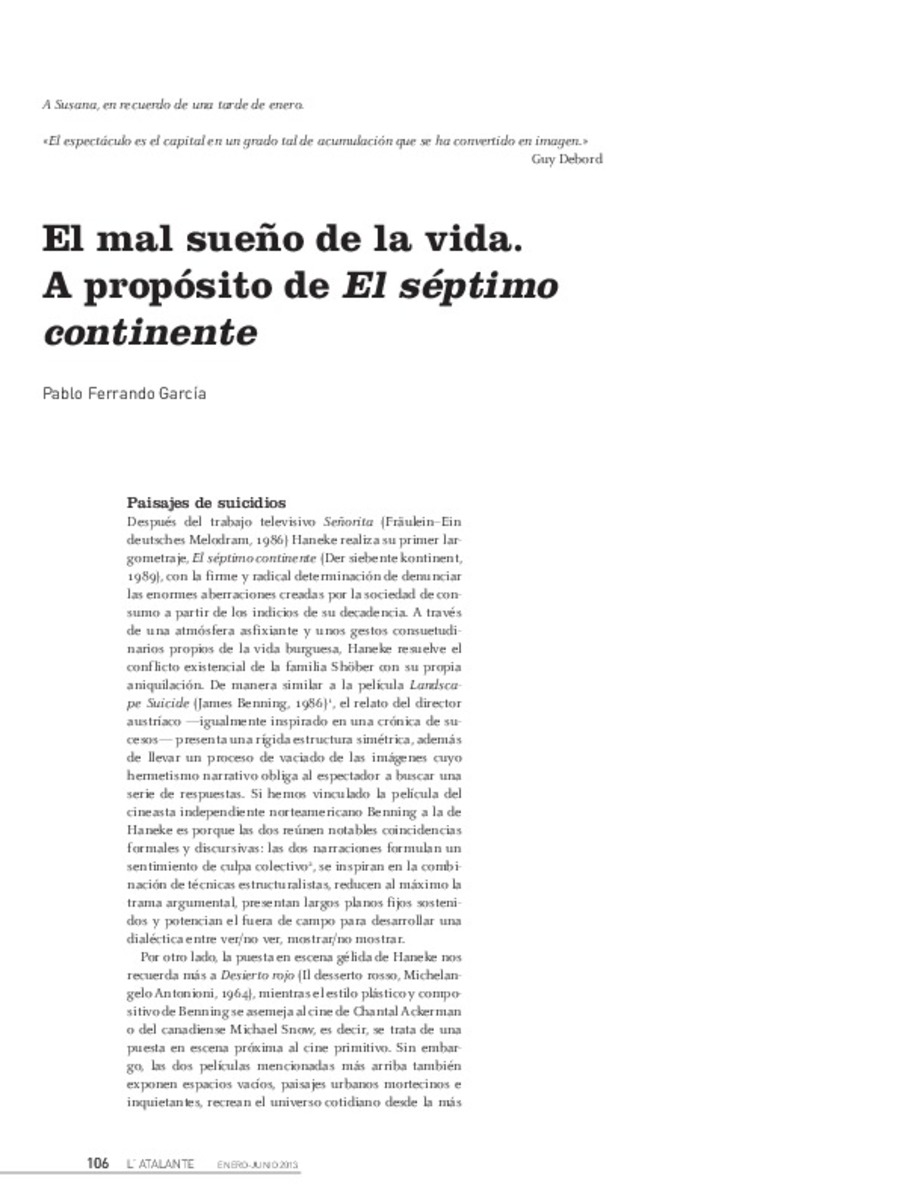Mostrar el registro sencillo del ítem
El mal sueño de la vida. A propósito de "El séptimo continente"
| dc.contributor.author | Ferrando García, Pablo | |
| dc.date.accessioned | 2014-06-04T07:23:51Z | |
| dc.date.available | 2014-06-04T07:23:51Z | |
| dc.date.issued | 2013 | |
| dc.identifier.citation | FERRANDO GARCÍA, P. El mal sueño de la vida. A propósito de "El séptimo continente", Atalante, n. 15 (1013), p. 106-111 | ca_CA |
| dc.identifier.uri | http://hdl.handle.net/10234/94372 | |
| dc.description.abstract | El texto presenta un análisis sobre la estructura general de El séptimo continente (Der siebente kontinent, Michael Haneke, 1989). Para ello establece un estudio comparativo entre ésta y Landscape Suicide (James Benning, 1986) dado que la película de Haneke debe mucho a la producción independiente norteamericana. Ambos filmes tienen enormes coincidencias formales ydiscursivas, se pone de relieve la naturalezaestructuralista, así como también el carácterminimalista de las tramas de cada unade ellas. A partir de este punto se resume la organización conjunta del relato hanekiano mediante los gestos cotidianos de la familia Shöber con el fin de subrayar la denuncia final: la autodestrucción familiar es llevada a cabo con la misma rutina y automatismo que como habían llevado sus propias vidas. A consecuencia de esto se cuestiona la articulación de un conjunto de símbolos y representaciones que han sido establecidos como modelo de vida y cuya encarnación bien podría visualizarse a través del American dream. A modo de concentrado se analizan sucintamente los planos que prologan el film para hacernos una idea de ese descenso a la locura y al horror. En suma, Haneke se identifica con el planteamiento del heterodoxo marxista Guy Debord a la hora de diagnosticar las señales de decadencia que se están produciendo dentro de la sociedad capitalista en la cual estamos inmersos. | ca_CA |
| dc.description.abstract | The paper presents an analysis of the overall structure of The Seventh Continent (Der siebente Kontinent, Michael Haneke, 1989). This provides a comparison between it and Landscape Suicide (James Benning, 1986) because Haneke's film owes much to the american independent production. Both films have huge formal and discursive matches, highlights the structural nature, as well as the minimalist character of the plots of each of them. From this point summarizes the joint organization of the haneke’s story through gestures Shöber family everyday in order to highlight the final report: familial self-destruction is carried out with the same routine and automatic as they had taken their own lives. A consequence of this question the articulation of a set of symbols and representations that have been established as a model of life and whose incarnation might well be viewed via the american dream. As discussed briefly concentrate planes that preface the film to get an idea of the descent into madness and horror. In short, Haneke is identified with the approach of the heterodox marxist Guy Debord diagnosed when signs of decay that are taking place within the capitalist society in which we operate. | ca_CA |
| dc.format.extent | 6 p. | ca_CA |
| dc.format.mimetype | application/pdf | ca_CA |
| dc.language.iso | spa | ca_CA |
| dc.publisher | Associació Cinefòrum L’Atalante | ca_CA |
| dc.relation.isPartOf | Atalante, n.15 (2013) | ca_CA |
| dc.rights.uri | http://rightsstatements.org/vocab/CNE/1.0/ | * |
| dc.subject | see / not see | ca_CA |
| dc.subject | fragmentation and off field | ca_CA |
| dc.subject | absence of catharsis | ca_CA |
| dc.subject | metaphorical blindness | ca_CA |
| dc.subject | banality | ca_CA |
| dc.subject | metonymy | ca_CA |
| dc.subject | Society of the spectacle | ca_CA |
| dc.subject | ver / no ver | ca_CA |
| dc.subject | fragmentación y fuera de campo | ca_CA |
| dc.subject | ausencia de catarsis | ca_CA |
| dc.subject | ceguera metafórica | ca_CA |
| dc.subject | banalidad | ca_CA |
| dc.subject | metonimia | ca_CA |
| dc.subject | sociedad del espectáculo | ca_CA |
| dc.title | El mal sueño de la vida. A propósito de "El séptimo continente" | ca_CA |
| dc.type | info:eu-repo/semantics/article | ca_CA |
| dc.rights.accessRights | info:eu-repo/semantics/openAccess | ca_CA |
| dc.relation.publisherVersion | http://www.revistaatalante.com/index.php?journal=atalante&page=article&op=view&path%5B%5D=49 | ca_CA |
Ficheros en el ítem
Este ítem aparece en la(s) siguiente(s) colección(ones)
-
COM_Articles [827]







